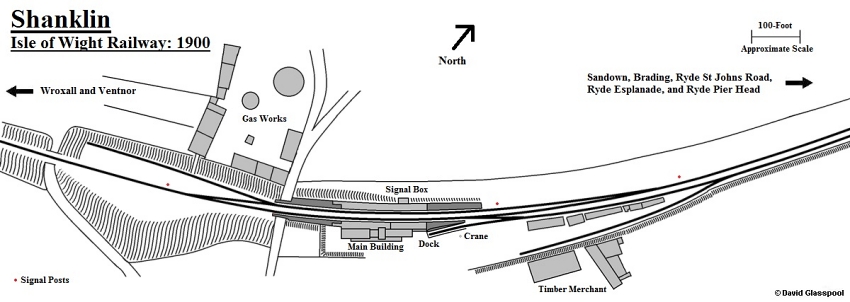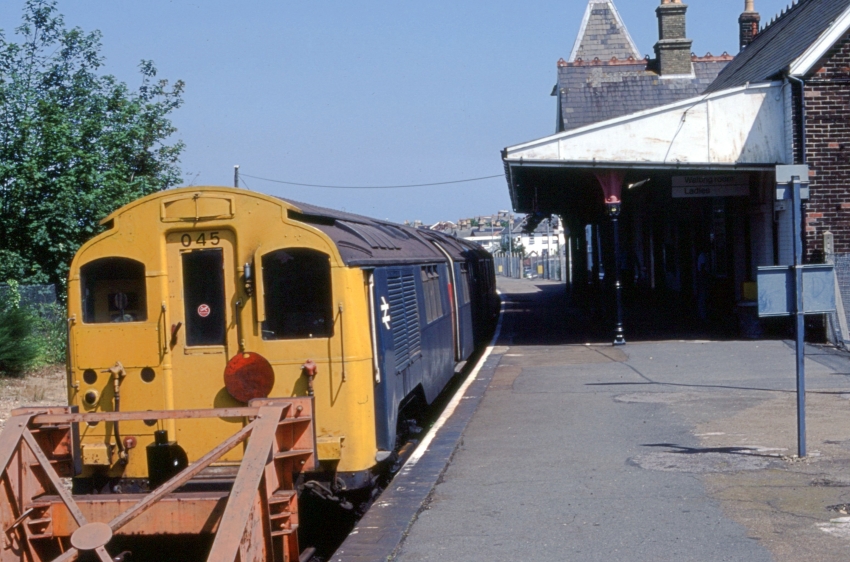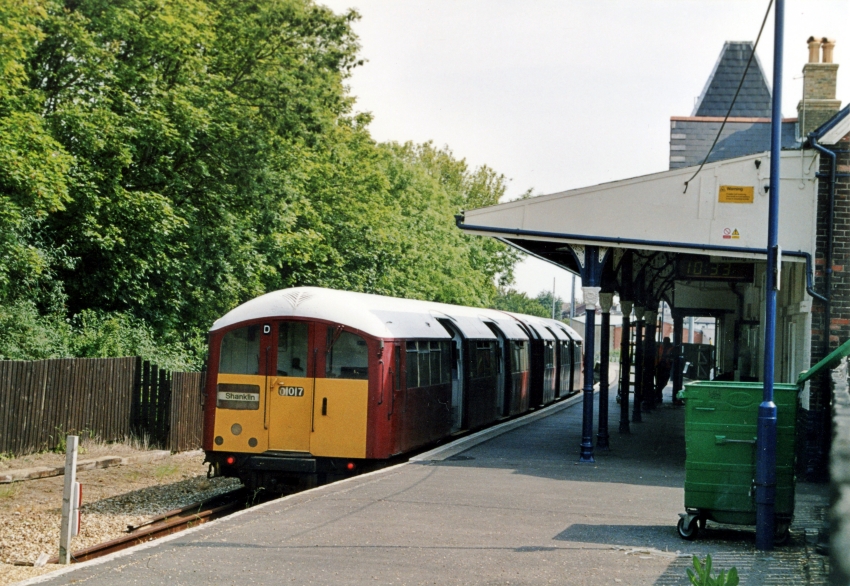Shanklin
As part of the alterations, the timber carriage shed was swept away, and in its place a small goods yard emerged. A northward-facing dock siding came into use behind the original platform, and across the yard could also be found a lengthy siding serving a timber yard. Both sidings made indirect connections with the Ventnor-bound running line, thus reversal manoeuvres into a long head shunt were required to gain access. South of the station, immediately beyond the road bridge, a siding was commissioned to serve the nearby gas works, and coal was conveyed from wagons to works by means of a chute running down the side of the embankment. From the outset, the line had been worked on the "staff and ticket" system, whereby the driver had to be in possession of a "staff" (a metal or wooden baton) in order to proceed along the single line. This was issued by the signalman or Station Master, and would be surrendered by the driver at the end of the line to permit another train to depart in the opposite direction. Should trains be required to follow one after the other in the same direction, drivers would instead be given a written ticket of authorisation from a signalman in possession of the staff, and be allowed to proceed along the single-track. In 1888, the "Webb-Thompson Electric Staff" system was invented by F.W. Webb and A.M. Thompson of the London & North Western Railway. This was implemented on the IWR from about 1893, and replaced the earlier "staff and ticket" arrangement. In brief, the electric staff system included signal boxes at either end of a single line (block section), in which the signalmen would communicate with each other electronically. Both signalmen together had to authorise the passage of a train over the single line in-between them, by the co-removal of a token from an interlocked machine at either end of the block section. Shanklin's layout was controlled from a Saxby & Farmer signal box positioned behind the canopy of the "up" platform, which operated an array of wooden-post semaphores.
On 31st December 1922, the IWR was absorbed into the LSWR, the latter of which itself became part of the Southern Railway on the following day. At Shanklin, an extension of the "down" platform canopy at its southern end took place, providing a wrap-a-round end. Service improvements were forthcoming, and from 1924 trains between Ryde Pier Head and Ventnor became half hourly in each direction, during the summer season. Nearly a decade later, the frequency increased yet again, for holiday traffic was becoming heavier. In 1933, trains between the Pier Head and Ventnor were run every twenty minutes in each direction. Previously, in 1932, a through service had commenced between Shanklin and Freshwater, calling at: Sandown; Merstone Junction; Newport; Carisbrooke; and Yarmouth. This ran five days a week and, a year later, was extended to Ventnor. Indeed, the IWR was enjoying a golden era under SR auspices, which had been kick-started in 1923 by the introduction of new motive power in the form of Class O2 0-4-4 Tank Engines. Further batches of second-hand stock had arrived from the mainland, and summer service frequencies were at an all-time high. Naturally, however, the subsequent British Railways era would be one of decline, in which it was proposed to kill off the island's entire rail network.
The SR formally became part of the nationalised BR on 1st January 1948, but had effectively been under Government control since 1st September 1939, as a result of World War II. The Isle of Wight's various other branches are for another website section, but needless to say their closure was undeniably swift under BR, with Merstone to Ventnor West closing to passenger traffic on 15th September 1952. Ten years later, Ryde to Ventnor, and Ryde to Newport and Cowes, were the the last remaining operational railway routes on the island. These two lines were also planned for total closure, but widespread opposition prompted a review in June 1964. In July of the following year, it was confirmed that the Ryde to Newport and Cowes line would still be closed, as would Shanklin to Ventnor, but the 8 miles and 28-chains between Ryde Pier Head and Shanklin would remain open. Restricted clearances prevented standard-width DMU stock being drafted in from the mainland, and although retention of steam traction was seen as a possibility, electrification was preferred. The latter was opted for as the result of surplus Tube stock of the Northern City Line being made available by London Transport. The cost of modernisation was estimated at £500,000 (£7,246,278 at 2008 prices), and was formally approved in November 1965. On 20th February of the following year, passenger services to Newport and Cowes ceased, and closure of the Shanklin to Ventnor section was effective from 18th April. The last day of steam haulage on the Ryde Esplanade to Shanklin section was 31st December 1966. There was a hiatus in service until the new electric timetable came into use on 20th March 1967.
Electrification involved raising the track level to allow the lower floors of the Tube stock to meet on the level with platforms. The first Tube vehicle had arrived on the island on 1st September 1966 for clearance tests. At Shanklin, both platforms were retained and their lines electrified with third rail. Sidings were abolished, goods facilities having been formally withdrawn on 6th December 1965, and the single-line between here and Sandown came under the control of the latter's signal box, worked on the tokenless block system. Only Shanklin's "down" platform saw regular trains, again controlled from Sandown's signal box, but at busy periods the second platform could be brought into use. For this, Shanklin's signal box was retained; most of the time it was switched out of use. The "up" side canopy was, nevertheless, completely abolished at the time of electrification, whilst that on the "down" platform remained in its entirety. In 1979, timetable revisions allowed the complete closure of Shanklin's signal box, the decommissioning of the "up" platform, and the lifting of this platform line. At the southern end of the layout, the bridge span which once carried the tracks to Wroxall and Ventnor was removed, thus shortening the platforms. To compensate for this, the remaining "down" platform was extended at its northern end. Furthermore, the "down" canopy was severely truncated to its north and south, thus it now extended for just 100-feet. The levers from the signal box were salvaged for re-use on the Isle of Wight Steam Railway, where they were inserted into a cabin at a new Wooton terminus.
Shanklin: 1900

Shanklin station after enlargement. Click the above for a larger version. © David Glasspool
1984

Class 485 No. 485045 is seen at a Shanklin station which had witnessed yet more rationalisation. The delightful "down" side canopy has lost its SR wrap-a-round end and been cut back to within the limits of the station building. The northern end of the canopy has also been removed, the signal box taken down, the second track lifted, and the "up" platform has disappeared under a sea of shrubs. Both platforms were demolished at their southern ends, permitting removal of the bridge span and the building of a brick wall and fence across the track bed, just beyond the new buffer stops. © David Glasspool Collection
13th June 2006

Ex-Bakerloo Line Tube stock of 1938 has been the order of the day since 1992, when the last Class 485 units were withdrawn. The former "up" platform was shortened even more than the "down" surface in 1980, and the brown fencing on the left now resides upon the demolished remains. © David Glasspool Collection
Return to the Kent Rail Homepage or alternatively, check for Updates.
Website & Copyright information - Links - Contact the Webmaster
